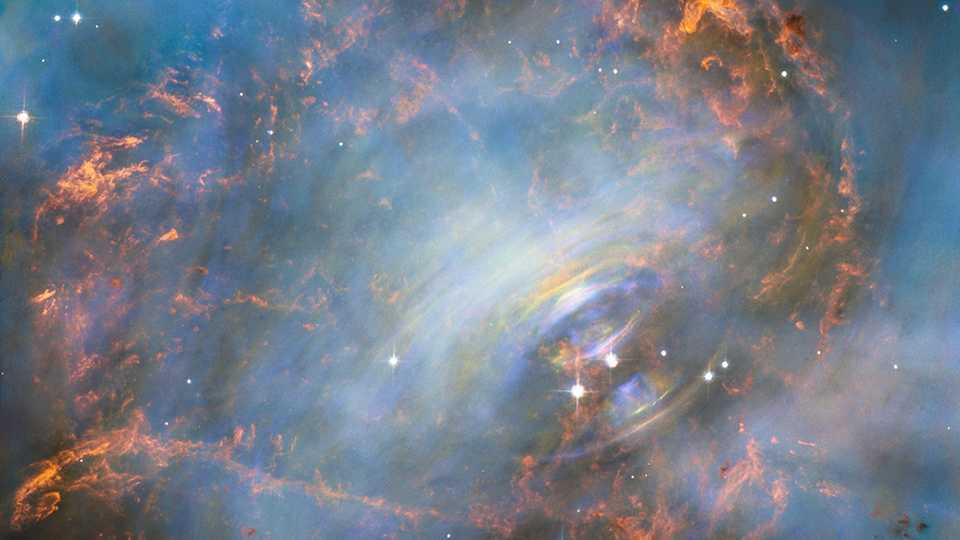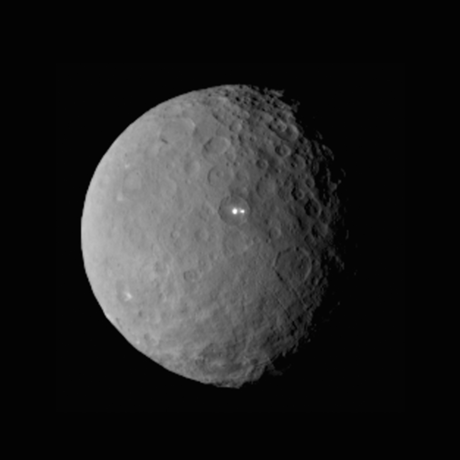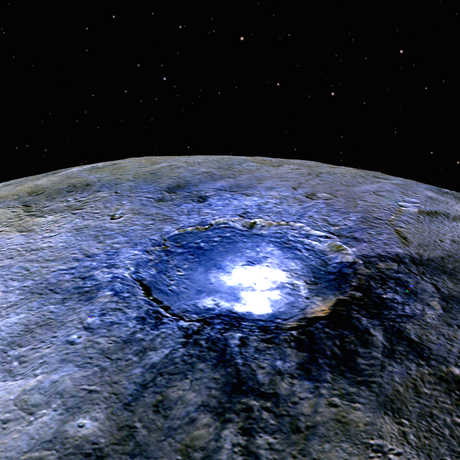Science News
Space Friday: Ceres, the Crab Nebula, and Galaxy Clusters

Dawn’s Mission Extension Plus Less Ice, More Salt on Ceres
After 5.6 billion kilometers (3.5 billion miles) traveled, 69,000 images taken, 2,450 orbits completed around Vesta and Ceres, and 132 GB of data collected, the Dawn mission officially completed the fourth and final phase of its primary mission on June 30 (just in time for Asteroid Day). To celebrate, scientists published two papers based on Dawn’s data regarding the composition of the largest asteroid—or smallest dwarf planet—Ceres. Both center around findings in one of its most prominent features, Occator Crater.
Some of the first—and most debated—features resolved on Ceres as the Dawn mission approached in March of last year were the mysterious white spots located in craters all across its surface. With Ceres’s proximity to the Sun and lack of atmosphere, water ice on its surface would sublimate away quickly, eliminating it as the likely culprit, leaving salts and minerals far more plausible. An earlier publication suggested that the spots contained magnesium sulfate. However, new infrared spectral data published last week in Nature revealed a different salt—sodium carbonate, a type of salt formed on Earth in hydrothermal environments, with some ammonia mixed in. This clarification in composition makes a difference in the potential origin of the salt deposits.
“The minerals we have found at the Occator central bright area require alteration by water,” said Maria Cristina De Sanctis, of the National Institute of Astrophysics, Rome. “Carbonates support the idea that Ceres had interior hydrothermal activity, which pushed these materials to the surface within Occator.”
The findings suggest that liquid brine (extremely salty water) may have existed beneath the surface of Ceres in the past few million years, welling up then evaporating away and leaving behind the bright spots seen today. The salts could be remnants of an ocean, or localized bodies of water, that reached the surface and then froze millions of years ago. The origin of the salt water itself, however, remains a mystery with poetic ideas including liquid water boiling close to the surface creating vents or subsurface ice heated by the impact that formed Occator Crater.
Speaking of impact craters stirring things up, prior to Dawn’s arrival at Ceres, many scientists anticipated that the dwarf planet would contain a substantial layer of subsurface ice. However, in another Ceres-related article last week in Nature Geoscience, the craters seem to be telling a slightly different story.
Surveys of the surface with the Dawn Framing Camera found that most of Ceres’s largest craters are more than two kilometers (more than a mile) deep compared to the surrounding terrain, meaning they have not deformed much over billions of years. Those substantial depths are too much for the subsurface below the dwarf planet’s rocky outer layer to be mostly made up of ice.These significant depths suggest that Ceres' subsurface is no more than 30 to 40 percent ice by volume, with the rest a potential mixture of rock and low-density materials such as salts or clathrates.
We will have plenty more updates from Ceres for at least the next year. NASA officially extended Dawn’s mission for at least the next fiscal year. It was also decided that rather than moving on to a proposed new target, asteroid Adeona, Dawn will remain in the stable polar orbit of the small dwarf planet indefinitely. –Elise Ricard
In the Heart of the Crab Nebula
On July 4, 1054, Chinese skywatchers reportedly saw the appearance in the sky of what they called a “guest star” that became so bright that it was seen in the daytime sky for 23 days. After it faded from view, it remained visible to the naked eye in the nighttime sky for nearly two years against the stars of what is today known as the constellation Taurus the Bull. While there’s some disagreement as to its precise location, all descriptions reference it to the star known today as Zeta Tauri, a star typically imagined as the tip of the southern horn of Taurus. (The star is also well known to many amateur astronomers by its ancient Babylonian name, “Shurnarkabti-sha-shutu,” simply because they like to say it—once they figure out how).
In 1758, French astronomer Charles Messier was searching the sky for a comet whose appearance in the sky had been predicted by Englishman Edmond Halley. This object would eventually be observed and come to be known as Halley’s Comet, but in the course of looking for it through his telescope, Messier mistook a fuzzy nebulosity that he saw near Zeta Tauri for the comet. Because of this, he decided to compile a list of such nebulosities as a guide for comet-hunters to avoid, lest they too mistake them for comets. The first target listed in Messier’s now famous catalog is the object near Zeta Tauri, which is now known to be about 6,500 light years away and often referred to simply as “M-1.” In the 1920s, astronomers including Edwin Hubble began to suspect that M-1 was the still-expanding remnant of an exploded star, or supernova—a suspicion that today is accepted as unequivocal fact.
Deep at the center of the nebula, we find the collapsed core of the exploded star. Called a neutron star, this amazing object contains about 1.4 times the mass of the Sun, compressed to a volume roughly ten kilometers (six miles) in diameter, or about the size of a city. As the core collapsed to an incredibly dense state, it rotated more rapidly, in the same way that a pirouetting ice skater spins faster as she pulls her arms in. The final result is a superfast rate of rotation that has been measured at about 30 times per second. Only the extreme density of the neutron star—which, in NASA’s terms, makes it 10 billion times stronger than steel—prevents it from flying apart. Lighthouse-like beams of energy are channeled by the neutron star’s powerful magnetic field, and as the beams sweep past Earth, the spinning neutron star is detected as a regularly-pulsating energy source, called a pulsar.
In 1844, because of its appearance in large telescopes, M-1 was dubbed the Crab Nebula. Many images have been taken in different wavelengths of electromagnetic energy, zeroing in on its center, where the collapsed core of the exploded star is located, revealing a cauldron of energetic activity.
Now, a combination of high-resolution views shows further details in the heart of the nebula, with different phenomena being represented by different colors. Surrounding the whirling neutron star are expanding vortices of charged particles, their rapid motion indicated by subtle rainbow-like fringes of color. The blue glow around the center of the nebula represents electrons in the neutron star’s magnetic field, moving at nearly the speed of light. Around this, red filaments reveal where ionized gas is still expanding away from the central pulsar, visible as the bright star nearest the oval feature at the center of the nebula.
The Crab Nebula is visible from dark locations through medium-size amateur telescopes during northern hemisphere winters, seen as a tiny, faint smudge just one degree of arc (two full Moon widths) northwest of Zeta Tauri. –Bing Quock
X-traordinary Measurements from a Short-lived Satellite
Earlier this year, the Japanese Hitomi X-ray Observatory spun out of control and disintegrated due to a chain of technical malfunctions just a month after it began its observations. But scientists, reporting this week in Nature, say that the data collected that first month are astounding. “Although the Hitomi mission ended tragically after a very short period of time, it’s fair to say that it has opened a new chapter in X-ray astronomy,” says Stanford’s Irina Zhuravleva.
In its short time, Hitomi observed the Perseus cluster of galaxies, an assemblage of thousands of galaxies bound together by gravity located about 240 million light-years away. Like other galaxy clusters, Perseus contains a vast amount of extremely hot gas—and at temperatures averaging 50 million degrees Celsius (90 million degrees Fahrenheit), the gas glows brightly in X-rays. But until now, little was known about the dynamics of the hot gas.
The data reveal the first views of the supermassive black hole stirring hot gas at the heart of the galaxy cluster, like a spoon stirring cream into coffee. This stirring is much less turbulent than expected, providing astronomers with another piece of the puzzle to measuring mass and growth within galaxy clusters.
“I’m surprised the hot gas is absorbing the power output of the black hole so quickly, so efficiently. The gas is relatively stable and isn’t getting pushed around as much as we thought,” says Brian McNamara, of the University of Waterloo. “Hitomi’s Perseus observation tells us that we can probably weigh distant galaxy clusters to greater accuracy than we can weigh our own Milky Way galaxy.”
These motions (see video here) could explain why galaxy clusters form far fewer stars than expected—a puzzling property that affects the way cosmic structures evolve. Over time, the gas should cool down and clump together to form stars. Yet there is very little star formation in galaxy clusters, and until now scientists were not sure why.
Previous missions before Hitomi had taken X-ray images of the Perseus cluster that revealed how giant bubbles of ultra-hot, ionized gas, or plasma, rise from the central supermassive black hole as it catapults streams of particles tens of thousands of light-years into space. Additional images of visible light from the cluster showed streaks of cold gas that appear to get pulled away from the center of the galaxy. However, until now it has been unclear what effect the plasma bubbles have on this intergalactic gas.
“From what we’ve seen in our data, the rising bubbles drag gas from the cluster center, which explains the filaments of stretched gas in the optical images,” explains Zhuravleva. “In this process, turbulence develops. In a way, the bubbles are like spoons that stir milk into a cup of coffee and cause eddies. The turbulence, in turn, heats the gas and suppresses star formation in the cluster.”
“The data Hitomi sent back to Earth are just beautiful,” concludes Stanford’s Norbert Werner. “They demonstrate what’s possible in the field and give us a taste of all the great science that should have come out of the mission over the years.” –Molly Michelson


